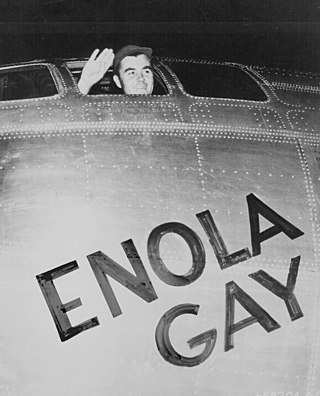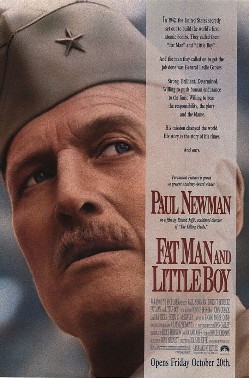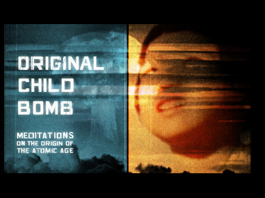
The Enola Gay is a Boeing B-29 Superfortress bomber, named after Enola Gay Tibbets, the mother of the pilot, Colonel Paul Tibbets. On 6 August 1945, during the final stages of World War II, it became the first aircraft to drop an atomic bomb in warfare. The bomb, code-named "Little Boy", was targeted at the city of Hiroshima, Japan, and destroyed about three-quarters of the city. Enola Gay participated in the second nuclear attack as the weather reconnaissance aircraft for the primary target of Kokura. Clouds and drifting smoke resulted in Nagasaki, a secondary target, being bombed instead.

Little Boy was the name of the type of atomic bomb used in the bombing of the Japanese city of Hiroshima on 6 August 1945 during World War II, making it the first nuclear weapon used in warfare. The bomb was dropped by the Boeing B-29 Superfortress Enola Gay piloted by Colonel Paul W. Tibbets Jr., commander of the 509th Composite Group, and Captain Robert A. Lewis. It exploded with an energy of approximately 15 kilotons of TNT (63 TJ) and had an explosion radius of approximately 1.3 kilometers which caused widespread death across the city. The Hiroshima bombing was the second nuclear explosion in history, after the Trinity nuclear test.

Leslie Richard Groves Jr. was a United States Army Corps of Engineers officer who oversaw the construction of the Pentagon and directed the Manhattan Project, a top secret research project that developed the atomic bomb during World War II.

Fat Man and Little Boy is a 1989 American epic historical war drama film directed by Roland Joffé, who co-wrote the script with Bruce Robinson. The story follows the Manhattan Project, the secret Allied endeavor to develop the first nuclear weapons during World War II. The film is named after "Little Boy" and "Fat Man", the two bombs dropped on the Japanese cities of Hiroshima and Nagasaki, respectively.

Charles William Sweeney was an officer in the United States Army Air Forces during World War II and the pilot who flew Bockscar carrying the Fat Man atomic bomb to the Japanese city of Nagasaki on August 9, 1945. Separating from active duty at the end of World War II, he later became an officer in the Massachusetts Air National Guard as the Army Air Forces transitioned to an independent United States Air Force, eventually rising to the rank of major general.

Hibakusha is a word of Japanese origin generally designating the people affected by the atomic bombings of Hiroshima and Nagasaki at the end of World War II.
George Anthony Weller was an American novelist, playwright, and journalist for The New York Times and Chicago Daily News. He won a 1943 Pulitzer Prize as a Daily News war correspondent.

Project Alberta, also known as Project A, was a section of the Manhattan Project which assisted in delivering the first nuclear weapons in the atomic bombing of Hiroshima and Nagasaki during World War II.

Hiroshima is a 1995 Japanese-Canadian war drama film directed by Koreyoshi Kurahara and Roger Spottiswoode about the decision-making processes that led to the dropping of the atomic bombs by the United States on the Japanese cities of Hiroshima and Nagasaki toward the end of World War II. The three-hour film was made for television and had no theatrical release.

Atomic tourism or nuclear tourism is a form of tourism in which visitors witness nuclear tests or learn about the Atomic Age by traveling to significant sites in atomic history such as nuclear test reactors, museums with nuclear weapon artifacts, delivery vehicles, sites where atomic weapons were detonated, and nuclear power plants.

Jacob Beser was a lieutenant in the United States Army Air Forces who served during World War II. Beser was the radar specialist aboard the Enola Gay on August 6, 1945, when it dropped the Little Boy atomic bomb on Hiroshima. Three days later, Beser was a crewmember aboard Bockscar when the Fat Man bomb was dropped on Nagasaki. He was the only person to have served as a strike crew member of both of the 1945 atomic bomb missions.

On 6 and 9 August 1945, the United States detonated two atomic bombs over the Japanese cities of Hiroshima and Nagasaki. The bombings killed between 129,000 and 226,000 people, most of whom were civilians, and remain the only use of nuclear weapons in an armed conflict. Japan surrendered to the Allies on 15 August, six days after the bombing of Nagasaki and the Soviet Union's declaration of war against Japan and invasion of Japanese-occupied Manchuria. The Japanese government signed the instrument of surrender on 2 September, effectively ending the war.

The Beginning or the End is a 1947 American docudrama film about the development of the atomic bomb in World War II, directed by Norman Taurog, starring Brian Donlevy, Robert Walker, and Tom Drake, and released by Metro-Goldwyn-Mayer. The film dramatizes the creation of the atomic bomb in the Manhattan Project and the bombing of Hiroshima.

Substantial debate exists over the ethical, legal, and military aspects of the atomic bombings of Hiroshima and Nagasaki on 6 August and 9 August 1945 respectively at the close of World War II (1939–45).
First Into Nagasaki: The Censored Eyewitness Dispatches on Post-Atomic Japan and Its Prisoners of War is a collection of reports by Chicago Daily News foreign correspondent George Weller. Originally written in 1945, but not approved for publication by Gen. Douglas MacArthur's military censors. The reports were collected and edited by the author's son Anthony Weller, and published for the first time in 2006.
This is a list of cultural products made about the atomic bombings of Hiroshima and Nagasaki. It includes literature, film, music and other art forms.

Tsutomu Yamaguchi was a Japanese marine engineer who survived both the Hiroshima and Nagasaki atomic bombings during World War II. Although at least 160 people are known to have been affected by both bombings, he is the only person to have been officially recognized by the government of Japan as surviving both explosions.

Original Child Bomb is a 2004 documentary about the aftermath of the atomic bombings of Hiroshima and Nagasaki. The film premiered at the 2004 Tribeca Film Festival and was aired on many stations on August 6, 2005, the 60th anniversary of the bombings. The title of the film was inspired by Thomas Merton's poem of the same name, which is quoted throughout the film.

The Bomb is a 2015 American documentary film about the history of nuclear weapons, from theoretical scientific considerations at the very beginning, to their first use on August 6, 1945, to their global political implications in the present day. The film was written and directed by Rushmore DeNooyer for PBS. The project took a year and a half to complete, since much of the film footage and images were only recently declassified by the United States Department of Defense.
















